Brother Can You Spare A Dime? For a Bag
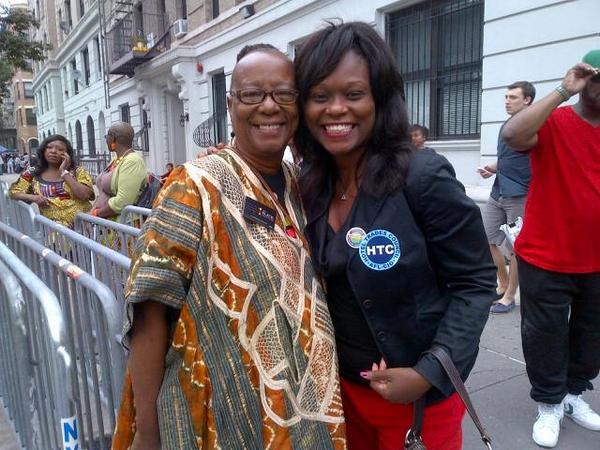
The author, Bertha Lewis, left (photo: @Vote_Bichotte)
A recent New York Times column examined "The Source of New York's Greatness," and its conclusion was no surprise: our greatness comes from our status as the preeminent melting pot, both culturally and economically. We are home not just to doctors, lawyers, and bankers, but to bodega owners, shoe shiners and deli chefs. So I wonder what one of our great orators would say about the New Dime Bag?
New Yorkers, YOU BEEN HAD! A ten cent tax on plastic bags, specifically the regressive tax introduced by Council Members Brad Lander and Margaret Chin, is counter-intuitive, and hurts the working class and small business owners that make our city strong. Our communities are still struggling to make ends meet, still suffering economically from the recession, and still suffering from the effects of Hurricane Sandy. We shouldn't be asking our citizens to hand over any more of their hard-earned money at the grocery counter, especially when their communities won't reap the benefit of their investment.
New Yorkers, YOU BEEN TOOK! It is hard enough for our city's working families to balance multiple jobs, multiple children, and a checkbook, without having to also worry about whether or not they remember to bring a reusable bag. Council Members Lander and Chin have tried in part to alleviate this issue by proposing to waive the tax for those on food stamps. Unfortunately, this "remedy" creates more problems than it solves. Despite an exemption for SNAP recipients, New York's working poor must still pay this tax.
New Yorkers, YOU BEEN HOODWINKED! Additionally, many small businesses are opposed to this legislation, as they would be unnecessarily burdened to enforce it. The bill is very clear on how businesses will be fined, but is conveniently vague on how small business owners should keep track of their plastic bag compliance. The bill does not mandate any sort of paper trail to help businesses prove that they are in fact complying with the new tax. Why are we making things more confusing for our small businesses, instead of helping them run more efficiently?
New Yorkers, YOU BEEN LED ASTRAY! This bill is supposed to help the environment, but the goals don't match up to reality. Plastic bags make up only 2% of the waste stream, and are nowhere near the top of the list of glaring environmental priorities for our citizens. Reusable bags are also produced overseas from petroleum, a process that is harmful to the environment. Additionally, plastic bags are 100% recyclable, and are reused in a number of ways around the house.
New York City Council has RUN AMOK! If Council Members Lander and Chin really want to make an impact, they should focus their efforts on causes that more directly benefit constituents. A recent survey found that, by a margin of 2:1, voters believe taxing plastic bags is a distraction. New Yorkers think job creation (24%), affordable housing (22%) and quality public schools (18%) are the most important issues for lawmakers to address.
Bag tax supporters like Lander and Chin hurt their constituents by further supporting the punitive and regressive tax on plastic shopping bags. Before writing and supporting legislation, our elected officials should take the time to think through their actions and consider the range of effects their proposals will have on their communities, and not just themselves. Think about all New Yorkers. DUMP THE DIME BAG!
***
Bertha Lewis is President and Founder of the Black Leadership Action Coalition (BLAC).
Do you have an op-ed idea or submission for Gotham Gazette? Send it to Executive Editor Ben Max: This email address is being protected from spambots. You need JavaScript enabled to view it.
New York at Bargain Basement Prices
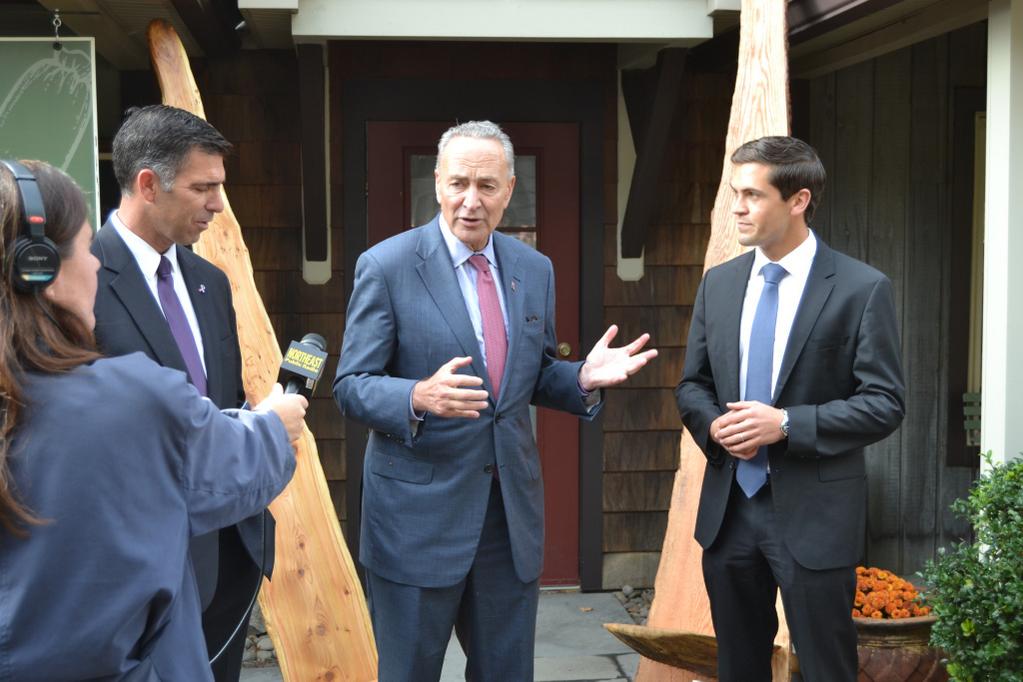
Sen. Schumer, middle, with Congressional candidate Sean Eldridge, right (photo: @SeanEldridge)
The Center for Responsive Politics estimates that candidates and their supporters spent nearly $4 billion in this year's election. For once, however, New York is a bargain, one of the least expensive places in the country to win a seat in Congress.
(Estimates are based on data released from the Federal Election Commission on Nov. 4)
It helps that neither of our two Senators were up for re-election this year. The top five U.S. Senate races alone totaled nearly $180 million in direct spending, with Minority (soon to be Majority) Leader Mitch McConnell spending $25 million to defeat his opponent, Alison Grimes, in Kentucky.
But in the House, a slew of uncompetitive races meant the entire 27-member New York delegation together raised just $42.1 million, an amount less than the top four House Republicans, who combined to raise $49.3 million. And special praise, perhaps, should go out to Congressman Jose Serrano, who raised the sixth least amount ($178k) of all House incumbents, and won with 97% of the vote. We can only hope that Congressman Serrano was busy legislating for New Yorkers, rather than spending most of his time on the phone to donors, like many of his colleagues across the country.
There were a few expensive campaigns in the state, especially the 19th district race between Congressman Chris Gibson and Sean Eldridge. Together they raised more $7 million, and the race ranked in the top 10 in terms of dollars raised in House.
Of course, just because the incumbents in the state weren't that busy raising money, didn't mean our state was completely left out. New York remains the place where candidates and Super PACs from across the country come to raise money. The state's residents were third behind the District of Columbia ($298 million) and California ($294 million) with $192 million in contributions (82% from New York City alone), two thirds (61%) of which went to Democrats (figures based on reporting as of Oct. 25). New Yorkers in the Upper East Side's 10022 zip code alone gave $30 million, second only to those in 94104 (San Francisco, CA) which gave $73 million.
In 2016, things may change for our state. Not only is Senator Schumer up for re-election, we may have our own, semi-home grown candidate in the presidential race. We escaped the full political ad blitz in 2014, but we may not be so lucky in two years.
Regardless of who does or does not ultimately enter the presidential contest, total spending on the campaign is likely to dwarf this midterm year and all previous presidential year elections. If historical patterns hold, it is likely that total spending in 2016 will top $8 billion, making it the most expensive campaign in U.S. history. Candidates will again seek out New Yorkers to support their bids for elected office, as will organizations with a special interest in certain issues. We may even get to see more of those salacious attack ads that voters in Georgia, Kentucky, and New Hampshire are probably glad to be rid of for a little while.
***
Heath Brown, Ph.D., is assistant professor in the Department of Public Management, John Jay College, City University of New York. You can follow him @heathbrown
Ghosts of Elections Past

Assembly Speaker Sheldon Silver (photo: @erinmdurkin)
Our annual day of spooks and scares has come and gone, but it's Election Day when I'm truly haunted. I know that when I'm in the voting booth I'll feel the ominous lurking of undead politicians—the ones who just won't stay buried. On the Upper East Side where I live, for example, the spectre of soon-to-be-former Assembly Member Micah Kellner lingers.
Just last week, former Court of Appeals Judge Howard Levine upheld the Assembly Ethics Committee's decision that Kellner had through his inappropriate flirting with multiple employees created an "abusive and hostile" workplace. Kellner, in case you don't remember, is the one who told a junior staff member in her twenties during an online chat, that he "wouldn't mind falling asleep with her but not remotely."
Since sexual harassment in the workplace disproportionately affects women, I took enormous pleasure this September in supporting a worthy woman (Rebecca Seawright, who won the Democratic primary) to hold the seat Kellner is vacating. It looked like we would finally be rid of him.
My revenge-vote moment was ruined, however, when I cast my eye further down the ballot. There it was: Micah Kellner for State Committee Member. And then that night, Micah Kellner winning. I didn't vote for him, but 2,614 others did. Micah Kellner is still in elected office, folks, and while he told The New York Observer that "This isn't some comeback or rehabilitation," it sure looks like that's what he's planning.
For some infuriating reason, sexual misconduct does not seem to be a matter that male politicians consider serious enough to make them think twice about running for office. Just look at last year, when Kellner and Vito Lopez both attempted—and lost—runs for City Council amid scandal. (Lopez, after resigning from the Assembly, remains a State Committee Member like Kellner.)
It is deeply disturbing to know that multiple sexual harassment claims, which Kellner dismissively calls "sensationalized, five-year-old allegations," weren't enough to make Kellner question whether he should continue to run, then or now.
Even more upsetting: this time we let him win.
Kellner, Lopez, and other politicians seem to think these issues are awkward, but surmountable. They don't believe that their sexual misconduct means they shouldn't get to hold public office. This attitude of entitlement and exception sends a message to people—primarily women—that if they are harassed by male superiors, it doesn't matter. And it sends an even more insidious message when we, the voters, don't hold them accountable.
On a much grander stage, entitlement and exception led NFL Commissioner Roger Goodell and Ravens owner Steve Bisciotti to attempt their despicable cover-ups of 'the Ray Rice incident.' These powerful men tolerated the intolerable in order to protect their jobs and the reputations of their respective organizations. Doing the right thing wasn't important enough to them until real public pressure built.
Entitlement and exception led Assembly Speaker Sheldon Silver to attempt to hide Lopez's harassment with a confidentiality clause in the secret settlement that was requested by Lopez, not the female staffers he harassed. Not that Lopez and Kellner are isolated incidents—see the list of accusations against former Assembly Member Dennis Gabryszak for still other examples of the behaviors that have occurred on Silver's watch.
Silver is currently facing claims that he "aided and abetted" Lopez's pattern of abuse through his failure to take official action. This is not mere rhetoric: Staten Island District Attorney Daniel Donovan, serving as special prosecutor to investigate the case, concluded that Silver's deliberate behavior "encouraged" Lopez to continue harassing. Protecting the Assembly's interests, Donovan wrote in his report, "outweighed any interest in investigating or disciplining Assembly Member Lopez or in preventing similar occurrences in the future." [emphasis added]
So there it is: the choices of Silver, Goodell, Bisciotti, and other leaders who look the other way encourage abusers and harassers to keep abusing and harassing. They know that under leaders like these, they won't have to pay. We may not be able to elect the NFL Commissioner or oust an owner, but we can do something about candidates like Silver (who faces a challenger on Election Day), Lopez, and Kellner. When we continue to vote these men into office—or don't bother to vote against them—we are equally complicit in perpetuating these patterns of abuse and harassment.
If we refuse to tolerate sexual harassment and attitudes of entitlement and exception when we're at the polls, then those in power will truly feel that they have something to lose. But until the majority of us take that stand, sexual harassers will continue to operate with impunity.
In September, Kellner bet on the voters not caring enough about his sexual misconduct when it wasn't on the front page. His victory is our loss. Next time he or a similar candidate is on the ballot, we need to do better—for women, for workers, and for ourselves, the voters of New York who have a choice.
***
Sara Gold is a community organizer active in local issues and politics. She has been a resident of Assembly District 76 for three years. Follow her on Twitter @saragold2
Do you have an op-ed idea or submission for Gotham Gazette? Send it to Executive Editor Ben Max: This email address is being protected from spambots. You need JavaScript enabled to view it.
Hate Hyper-Partisanship? Support Redistricting Reform Now
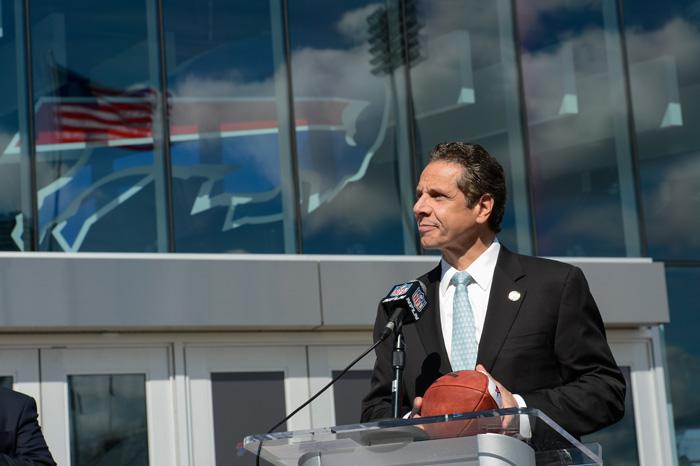
Gov. Cuomo is among those who have expressed support for Prop 1 (photo: @NYGovCuomo)
This column originally appeared at The Daily Beast
With the congressional reelection rate at 95 percent, it's no wonder many voters won't bother to show up Tuesday. But New Yorkers have an important chance to reform their rigged system.
After some $4 billion spent on the 2014 midterms, voter turnout is expected to be down again this Election Day. It's no wonder. The past few years of ugly gridlocked bloodsport politics have driven many Americans out of the arena in disgust.
But there's a stark disconnect between anti-incumbent anger at the least popular, most polarized, and least productive Congress in U.S. history and the 95 percent reelection rate most of the gutless wonders on Capitol Hill have come to expect.
Indeed, 77 members of Congress are facing no opposition at all this fall, depriving voters in their districts of any choice on Election Day. Of course turnout is down: For many voters, there's no reason to show up.
This sick status quo is a result of the rigged system of redistricting. Every 10 years, after the Census, legislators get together and draw district lines in collusion. Politicians pick their people rather than people picking their politicians.
After winning the 2010 elections, Republicans drew enough safe seats to give them something close to a lock on the House of Representatives for the next decade. Two years later, Democrats won half a million more votes for Congress than Republicans did, but the GOP was able to keep control of the House easily. This corrupt bargain results in a decade-long stasis, with far-reaching implications.
In the South, for example, white congressional Democrats have been essentially redistricted out of existence, with Republican-controlled legislatures clustering oddly shaped minority districts in urban areas while leaving lily-white rural and suburban majorities for themselves.
Outcomes are similarly lopsided in swing states like Pennsylvania, where Democrats won 83,000 more votes statewide in the 2012 congressional elections and won five House seats, while Republicans won 13.
Usually, voters have to wait 10 years to have a chance to reform the rigged system of redistricting, and even then the party in power tends to live by the maxim "to the victor go the spoils."
Don't be fooled by high minded-sounding excuses for inaction. This is the best shot we've got for holding professional partisans accountable to the people.
But this year, New Yorkers have a shot at making real changes through a ballot initiative sonorously known as Prop 1. It represents perhaps the last, best chance to reform the incumbent protection racket in the Empire State, taking the power from politicos and lobbyists with more independence and transparency than ever before.
First, consider the septic depth of the problem. New York has a 97 percent reelection rate for state lawmakers, although 28 elected officials have been forced from office on corruption charges over the past decade. You're more likely to leave office in New York state in handcuffs than to lose a general election. No wonder the state ranks toward the bottom in voter turnout.
Every 10 years, the parties collude on district lines drafted by the Assembly speaker and Senate majority leader aided by lobbyists, doling out favors and punishing those rare independent-minded officials who break with the party line. The result is safe seats that lead to apathy and voter impotence, leading logically to ever-declining voter turnout. Overall, 46 percent of legislative incumbents, almost half, were uncontested in their reelection efforts. In central New York this year, there is no option other than the six incumbents on the ballot for state Senate.
But Prop 1 could be the turning point. Legislators and lobbyists would be kicked out of the process and replaced with an independent commission that ensures bipartisan and third-party representation, and a super-majority for passage. New rules would specifically forbid partisan gerrymandering, barring the favoring of incumbents while preserving common-sense communities of interest and protecting minority representation. No more cynically cutting opposition candidates out of a district for petty political purposes. More public input and transparency than ever before.
Not surprisingly, professional partisans hate Prop 1. What's more surprising is how divided so-called good government groups in New York are over this plan to reform redistricting. (Full disclosure: I'm on the board of one of the groups supporting the effort, Citizens Union, but I've been writing in favor of redistricting reform for over a decade.)
So let's take on the twin reasons for opposing Prop 1. The first comes fashionably cloaked in idealism, from self-styled political reformers who say this reform doesn't go far enough. Reality check: Perfect is never on the menu, especially in Albany. Prop 1 is largely modeled on the exhaustively lauded reform in Iowa. In addition, New York's reform would create an enforceable ban on partisan gerrymandering that would allow citizens to hold the legislature accountable by taking legislators to court if necessary. And unlike in California, which has frequent ballot propositions that amount to direct democracy—and which led to a successful redistricting reform earlier this decade—New York requires two consecutive votes of the state legislature on anything that could be considered a constitutional amendment. That happened under massive public pressure, led by the late New York City mayor Ed Koch, in the run-up to 2012. It won't happen again anytime soon because it's simply not in legislators' general interest to give up power. So opposition to Prop 1 on allegedly idealistic grounds is essentially an endorsement of the status quo. Delay is denial.
The second reason is rarely heard in polite company but it's the more honest and realistic reason: Liberal Democrats see their chance to run the table after 2020. Because the national GOP has moved so far right, New York is trending toward becoming a one-party state, and some of the deepest policy debates come from two competing wings of the Democratic Party. Redistricting reform could end up ensuring that Republicans and a handful of third parties keep a degree of influence via inclusion when it comes time to draw up the lines, rather than allowing Democrats to dominate all decisions.
But don't take my word for it. Now indicted Democrat state Sen. Malcolm Smith explicitly said the same thing in 2010: "With the Democrats in control of the state Senate, we are going to draw the lines so that Republicans will be in oblivion in the state of New York for the next 20 years."
Ballot propositions often seem like afterthoughts in elections, and the phrase "redistricting reform" can make even civically engaged eyes glaze over. But if you're one of the millions of Americans sickened by the extreme polarization, hyper-partisanship, and gridlock that's making a laughingstock of our democracy, you should care about the real-time fight for this fundamental election reform.
Don't be fooled by high minded-sounding excuses for inaction. This is the best shot we've got for holding professional partisans accountable to the people. If we fail, the ugly, cynical situation is guaranteed to get worse for decades to come. If we succeed, the result will be more competitive general elections and increased voter turnout. For New Yorkers, the choice is yours and the time is now.
This column originally appeared at The Daily Beast
***
John Avlon is the editor-in-chief of The Daily Beast
Note: Gotham Gazette is an independent publication of Citizens Union Foundation, sister organization of Citizens Union
Why I'm Voting 'Yes' on the Smart Schools Bond Act, Proposition 3
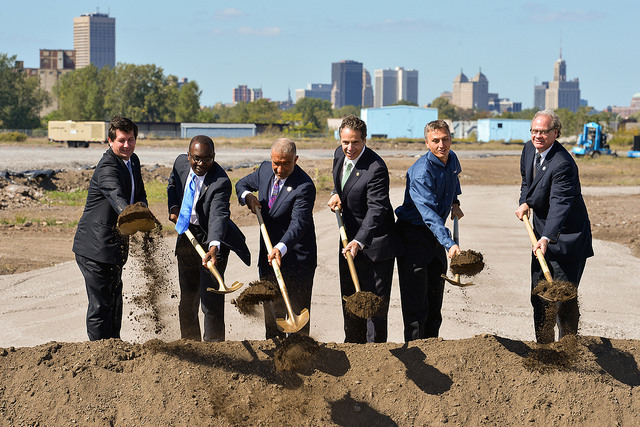
Gov. Cuomo at an event in Buffalo (photo: Governor's Office via flickr)
There has been much controversy and confusion over the Smart Schools Bond Act, which voters will approve or deny by voting on Tuesday, Election Day. Proposition 3 on the back of ballots, the Smart Schools Bond Act would authorize the sale of bonds to generate $2 billion statewide for capital funding. Each school district can use the revenue in the following ways:
· Purchasing educational technology equipment and facilities, such as interactive whiteboards, computer servers, desktop and laptop computers, tablets and high-speed broadband or wireless internet.
· Constructing and modernizing facilities to accommodate pre-kindergarten programs and replacing classroom trailers with permanent instructional space.
· Installing high-tech security features in school buildings.
While I and many other education advocates including Diane Ravitch are fervently opposed to using any bond revenue for the purchase of devices like laptops or tablets that have a useful lifetime of only a few years, as the interest on the bond act is repaid over twenty or thirty years, it is clear that districts will have the choice of how to use these funds and have a broad array of options.
New York City is due to receive about $780 million if Proposition 3 is approved. The Department of Education's five year capital plan makes it clear that if the bond act passes, $490 million of city funds previously directed toward technology would now be diverted toward building more schools to alleviate overcrowding for smaller classes, creating 4,900 more seats, and the rest toward creating 2,100 seats for pre-kindergarten.
As the analysis in our report Space Crunch makes clear, the city's school capital plan is badly underfunded as is. Though it will includes less than 40,000 additional seats if the Bond Act is approved – and even fewer if it isn't – the real need is at least 100,000 seats, given existing overcrowding and projections of increased enrollment over the next five to ten years.
Moreover, we have thousands of kindergarten children on waiting lists for their zoned school each year, and many thousands more sitting in trailers, temporary structures which are long past their expected lifetime and many leaky and rotting away. While the New York Times reported 7,158 students in trailers, the real figure is likely more than 10,000 students, since the lower number does not include any of the thousands of high school students or many disabled children attending classes in these substandard structures.
I understand the reluctance of parents outside the city who fear wasted funds on computer devices, as in the Los Angeles iPad scandal, which led to the resignation of their superintendent, or the Amplify tablet fiasco in Guilford, North Carolina. Like them, I also oppose the proliferation of online testing and instruction, which is motivated primarily by the desire to eliminate teachers and to benefit data-mining educational technology companies, eager to make a buck off our kids. Class Size Matters successfully led the fight to stop the state's plan to share personal student information with the corporation called inBloom Inc., designed to facilitate the incursion of data-mining vendors in schools, and inBloom closed its doors last spring.
Yet voters elsewhere in the state have elected school boards and should be actively engaged in the decision-making of how to best use the proceeds of the Bond Act. In addition, all parents have the right to opt out of any online data-mining instructional or testing program that collects personal data, whether their children participate in this program at school or home, according to the Children's Online Privacy Protection Act (COPPA). They should exercise that right if they so choose. Class Size Matters and the national coalition we co-chair, the Parent Coalition for Student Privacy, will work to make sure that all parents are informed of their right to do so. We will also continue to fight for the right of children to be able to learn in smaller classes where they receive the personal attention of their teachers in uncrowded schools – and that's why I'm voting for Proposition 3 on Tuesday, and urge others to do the same.
***
Leonie Haimson is the Executive Director of Class Size Matters. Follow her on twitter @leoniehaimson
Report Shows Extent of Racialized Criminalization over last 30 years
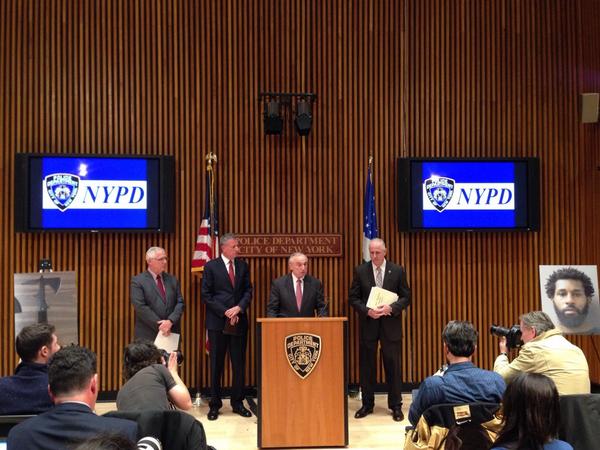
PC Bratton gives a briefing (photo: @NYPDNews)
This week's report on the frequency and distribution of misdemeanor arrests from 1980 to today from John Jay College of Criminal Justice provides clear evidence of what many have known for years. The NYPD is engaged in a wide-ranging social experiment in the mass criminalization of poor non-white New Yorkers.
The report shows that misdemeanor arrests have increased from about 60,000 a year in the early 80s to almost 250,000 today. Last year the arrest rate for whites was 1.2 percent, compared to an arrest rate of 6.4 percent for blacks and 4.4 percent for Hispanics.
Misdemeanor arrest rates for all three groups almost doubled from 1990 to 2010. White rates rose from 0.7 percent in 1990 to a high of 1.4 percent in 2011, black rates rose from a low of 3.6 percent in 1990 to a high of 7.5 percent in 2010. Hispanics saw a smaller increase, from 2.5 percent in 1990 to a high of 4.7 percent in 2010.
The bulk of the charges seen in this massive expansion involve low-level drug enforcement, especially of marijuana, prohibitions against commercial sex work, the many disorderly activities associated with living on the streets, and a variety of minor offenses mostly engaged in by young people such as graffiti and riding a bike on the sidewalk.
A shocking 25% of all misdemeanor arrests since 1980 have been for low-level drug violations, including 1 million arrests for marijuana.
The impact on the youngest New Yorkers has been the starkest. 16-17 year olds, who are treated as adults in New York State, saw their rate of arrest jump from 3.2% in 1980 to over 10% in in 2010. That means one in every ten 16-17 year olds was arrested for a misdemeanor in 2010.
Since these arrests are heavily concentrated in communities of color, in some places closer to 3 in every 10 young men in this age group face arrest each year. While that rate has since declined some, we are saddling these young people with permanent arrest records for low level drug involvement, jumping the turnstile, and playground fights in mind numbing numbers. The involvement of police in school safety enforcement has only worsened that trend by criminalizing schoolroom misbehavior as well.
During the 30-year period covered by the report, there has been an explosive increase in poverty and homelessness in New York City, especially among communities of color. African-Americans in particular are poorer and more socially isolated. Our City's response to this profound growth in inequality has been mass criminalization through the War on Drugs and the drive to eliminate "quality of life" problems through heavy-handed zero-tolerance policing, spurred on by a slavish adherence to the unproven "Broken Windows" theory. There is no substantial evidence that this massive expansion in misdemeanor arrests for drug violations, sex work, youthful misbehavior, and the activities associated with living out of doors is responsible for what is an international drop in crime. Hundreds of cities around the world have enjoyed major decreases in crime during this same period without relying on these techniques.
There is, however, clear evidence of the negative consequences of the increased usage of misdemeanor arrests on those arrested and the communities they come from. While disorderly behaviors have been reduced by aggressive policing, it has also torn apart families, destroyed livelihoods, and alienated many from the police, work, and city services.
In addition, the social problems being criminalized by the NYPD have shown no signs of improvement. Unemployment among young men of color remains at very high levels—in some communities topping 50%. Homelessness has increased throughout the period of the report. At the same time, drug use and drug availability remain pervasive, as does access to commercial sex. In other words, life for the poorest New Yorkers remains desperate and their problems are typically compounded by intensive criminalization.
Even if the massive increase in misdemeanor arrests was somehow responsible for a part of the crime decline, the social and financial costs are too high. The high costs of police time, court time, and over $100,000 per bed per year to run the prison on Rikers Island, means the arrest and jailing of people for even short periods is a gross misuse of limited city resources. The intensive criminalization of almost entirely minority populations flies in the face of any effort to reduce inequality, create equal opportunities for all, and improve the real quality of life in minority communities.
We must find lasting solutions to inequality that don't rely on criminalization. Drug use and drug dealing, sex work, and the disorderly behaviors associated with living on the streets are very real social problems, but criminalization at best papers over these problems and in some cases makes the problems and the lives of those involved worse. Resources devoted to criminalization must be repurposed to initiatives designed to create pathways out of homelessness and poverty. We must stop relying on homeless shelters, emergency rooms, and jails to deal with people living on the streets, we must find real economic opportunities for young people of color that take into account the challenges of educational failure, discrimination, and long-term poverty.
We can start with increasing permanent housing with transitional support services for those most in need, a massive expansion in public housing, and reforms to make living conditions better could improve life for hundreds of thousands. We need a major increase in the minimum wage to ensure that those who are working make enough to steer clear from participation in black markets. We need an increase in the standard of living for city employees, who have endured decades of austerity contracts, which has contributed to a thinning out of the middle class in the city, and we need further investment in non-punitive anti-violence initiatives for young people with wraparound services.
Finally we must decriminalize drugs and sex work and address whatever concrete harms are associated with them through community-based initiatives that don't rely on the police, courts, and jails.
The mayor is beginning to pursue some of these strategies, but the needs are huge and resources limited. He should stop wasting precious resources on criminalization and put them where they will do more good than harm.
***
Alex S. Vitale is associate professor of sociology at Brooklyn College and author of City of Disorder: How the Quality of Life Campaign Transformed New York Politics. He is senior policy adviser to hte Police Reform Organizing Project and serves on the New York State Advisory Committee to the US Civil Rights Commission. You can follow him on Twitter: @avitale
The Bronx's Growing Affordable Housing Problem
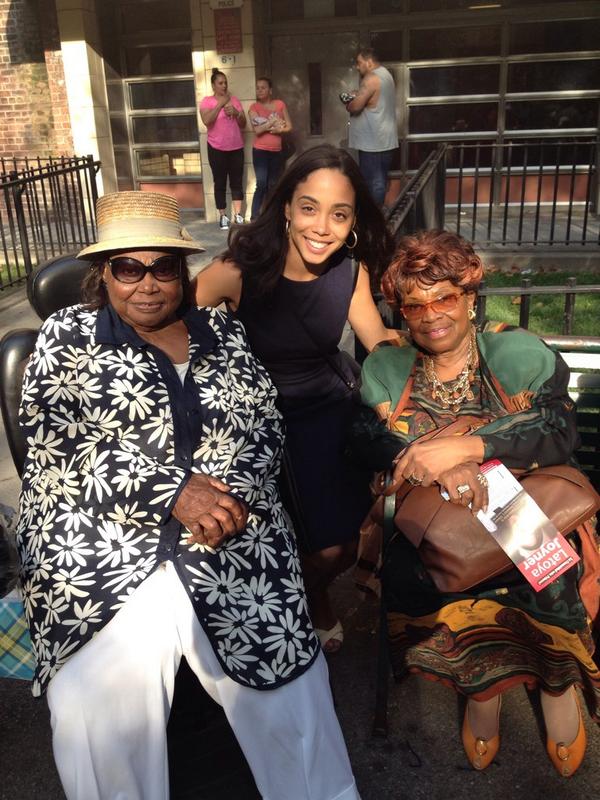
The author, middle, in the Bronx (photo: @JoinJoyner)
Affordability of housing is a growing problem for Bronx residents and families, more so than any other New York City borough. Having grown up in the area, and now working as a court attorney for a New York City Civil Court Judge, I have seen firsthand the troubles Bronx residents and families are facing. This is one reason I decided to run for the New York State Assembly in the 77th District.
The Institute for Children, Poverty & Homelessness said recently that the Bronx is in dire need of intervention. For instance, the number of homeless families in the Highbridge and Concourse sections increased 37%, to 633 families, from 2005 to 2010. Meanwhile, Bronx median rents increased by 10.5% to $954 per month. And the office of New York City Comptroller Scott Stringer pointed out in April that housing affordability – computed by rent-to-income ratios – decreased for every income group in the city. The hardest hit are those New Yorkers earning less than $40,000 a year. The Bronx median household income is $34,300.
Overall, the 1,084 homeless Bronx families make up the bulk of the city's homeless population, according to a recent Daily News report. And surging rent increases are partly to blame. As an active member of Community Board 4 and the Neighborhood Advisory Board, I know how integral affordable housing is to the lifeblood of this borough. Meanwhile, it's unclear whether current City policies are headed in the right direction. The Rent Guidelines Board voted 5-4 in June to raise rents by 1% for one-year lease agreements for the nearly one million city homes regulated under the stabilization law. If you plan to sign a two-year lease, your rent will rise by 2.75%, according to the board's decision.
But the families protected under these guidelines make up only 45% of all rental units in the City, according to a 2011 New York City housing survey conducted by the Census Bureau.
There may be some light at the end of the tunnel for tenants, however. Mayor Bill de Blasio's laudable "Five-Borough, Ten-Year Plan" to create or protect 200,000 affordable housing units over the next decade is a refreshing source of hope. According to the Community Service Society of New York, the city lost about 385,000 units of affordable housing between 2002 and 2011.
More than ever before, housing and rent regulations need a tune-up to address the current and future needs of Bronxites. With rent regulations up for renewal in Albany in June 2015, I will advocate to strengthen existing laws that will preserve and protect affordable apartments.
***
by Latoya Joyner, Democratic candidate for State Assembly in the 77th Assembly District. Find her on Twitter.
***
Note: publishing this op-ed is in no way an endorsement of Ms. Joyner's candidacy. Any candidate for office is welcome to submit a substantive op-ed to our editorial desk.
On the November ballot, Ms. Joyner, a Democrat, is opposed by Republican Esparanza Reyes Acosta and Conservative Party nominee Benjamin Eggleston.
Make Girls & Boys High School a Community School

Bernard Gassaway, left, talks about his resignation with Errol Louis (photo: @InsideCityHall)
The latest indictment of the Department of Education's management of failing schools was personified last week by Bernard Gassaway, the recently self-retired principal of Boys and Girls High School.
As he stepped down after five tortured years at the helm of the storied Bed-Stuy school, Gassaway took a verbal backhand to the DOE for failing to produce a plan to turn around the chronically failing school.
Predictably, the DOE shot back that Gassaway was the problem and that the they were planning to get rid of him anyway. But the hard truth is that we as a community – from DOE policy makers, Gassaway and school leadership to the parents and surrounding community-based institutions – ultimately failed the students of Boys and Girls and have been doing so for years.
I believe that the wider community of parents, teachers and neighborhood-based institutions - not just a singular principal or a fix-all plan handed down from Mount Tweed - has the resilience to produce a thriving learning environment if it is engaged through an effective community school model.
The mayor, having promised 100 community schools, has already designated 42 of them. Boys and Girls, in a cluster with other schools in the area, should be included in the next round.
Boys and Girls offers robust services as many community schools do, and is the site of countless community events. It also has the support of local politicians. However it struggles to offer the high academic standards and broad collaboration that are essential elements of effective community schools.
Specifically, parents and the surrounding community have remained under-informed regarding the school and under-engaged in determining its fate. A community school is not just a school within a neighborhood, but an academic and socio-economic hub for the surrounding community. Is this yet another supposed solution-in-a-box? No.
A community school model doesn't suddenly address all the challenges posed by poverty, institutional racism, and DOE bureaucracy. For instance, Boys and Girls will continue to fail under any plan, under any leader, if it continues to be used as the high school of last resort. But with adequate resources, intelligently invested in a community school model, Boys and Girls can begin to address the physical and emotional needs of not just the whole child, but the whole family.
While the Children's Aid Society in New York and Community in Schools, a national network of community schools, provide evidence that community schools demonstrate higher academic achievement levels, the model ultimately rises and falls on the strength and organizing skills of the community behind it.
This is a critical moment in the transition for Boys and Girls, which just named Gassaway's replacement. We've all seen principals, who, from a single centralized command, keep parents at a distance, see community institutions simply as service providers rather than partners, and treat peer schools as competitors. With so much pressure to meet city and state standards, schools often morph into fortresses and focus their attention inward. In effective community schools, principals are not dictators, but savvy community organizers and collaborators who know how to harvest the talent of the people and organizations around them.
Neither a new principal nor a new plan by the DOE will alone "fix" Girls and Boys. But within a community school framework, they can both provide a rare opportunity to re-think how to build investment and accountability among a broader set of people deeply engaged in the success of a school.
****
Mark Winston Griffith is the Executive Director of the Brooklyn Movement Center, a community organizing group developing leadership among Central Brooklyn parents.
Board of Correction Urgently Needs Reform
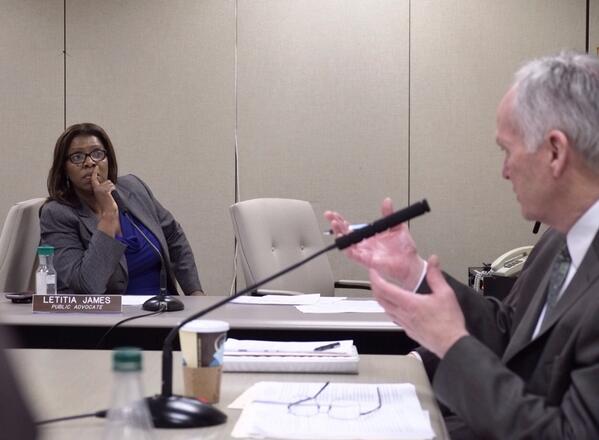
Public Advocate James listens to testimony from DOC Commissioner Ponte (photo: William Alatriste)
New York City Comptroller Scott Stringer issued the latest in a series of reports on mismanagement at Rikers Island last week, pointing out that the city's jail costs twice as much per bed as similar facilities in other big cities and is besieged with violence. Over the last year the New York City Department of Correction has been buffeted by scandals, lawsuits, and accusations of incompetence, corruption, and mismanagement. Throughout this period the Department's main oversight body, the New York City Board of Correction has been largely missing in action. Mayor Bill de Blasio needs to intervene to reinvigorate this important but largely dormant oversight body under his control.
The Board of Correction was created in 1957 as part of the City Charter and has the authority to make rules for the Department of Correction, conduct investigations of conditions and acts of misconduct, and issue public reports. It also has the ability to issue subpoenas and hold oversight hearings. The Board is made up of 9 members that oversee a professional staff of investigators and monitors.
Currently three of the nine seats on the Board are vacant and the chair is a holdover from the previous administration. The City Council chooses three members and the city's judiciary has a say in three more, but these must be approved by the Mayor, who also appoints three members directly, including the chair.
In August, US Attorney Preet Bharara issued a scathing report outlining a "culture of violence" among guards at Rikers Island, especially in its juvenile facilities, and raised major concerns about the use of solitary confinement for 16- and 17-year olds. Bharara has threatened legal action unless there are major reforms forthcoming.
His report was in response to widespread allegations of excessive force by guards—especially against juveniles, mistreatment including the deaths of people with mental illness in the "mental observation" unit, and widespread access to contraband, leading to the arrest of two corrections officers and a nurse in recent months. In August, The New York Times found that officer use of force had increased by 90% in the last 4 years.
The new Commissioner, Joseph Ponte, has recently been criticized for his appointment of William Clemons as Chief of Department. The city's Department of Investigation (DOI) had recommended demoting him after they found widespread failures to report violence in the juvenile facility where he was warden. The DOI, based on a review of video tapes and other documents, uncovered 375 incidents of violence that were not reported. Evidence of this wrongdoing was then withheld from the Department of Justice during its investigation.
The treatment of people with mental illness remains a profound problem at the jail. By some accounts 40% of those at Rikers have significant mental illness, including as many as 50% of juveniles. This vulnerable population is much more likely to be subjected to violence from both guards and prisoners and are heavily over-represented in solitary confinement units, where their conditions often worsen. Even the special mental observation unit is plagued with problems. In September of last year, Bradley Ballard died after days of neglect by guards and health workers—despite his obvious extreme distress. In March, homeless veteran Joseph Murdough literally baked to death in his cell because of faulty heating equipment and negligence, despite being on suicide watch.
This week the Associated Press reported that they have discovered 14 cases in the last 5 years where inmates at the jail died of preventable causes due to inadequate health care as a result of failure of guards to notify medical staff or failure of medical staff from the for-profit health group Corizon to provide needed treatment.
Mayor de Blasio needs to take a more active role in bringing about changes at Rikers. The Board of Correction, which could be a major player in investigating problems and making changes to rules and procedures has been at best a bit player. Despite the mandate to make public reports about problems at the jail, their last two reports, while useful, were remarkably thin—calling for enhancements on recreation time for people in solitary and pointing out some of the problems with mental health treatment through case studies of three inmates. After initially rejecting calls for major reforms to solitary, the Board is now preparing rules to restrict or eliminate its use for juveniles and those with mental illness and limit its use in general. Much more is needed.
There are currently three vacancies on the Board and the Mayor needs to step in and make strong appointments to revitalize the Board so that it can be a force in implementing reforms called for by advocates and the US Attorney. In particular, he needs to appoint a chair with a strong commitment to active intervention and a mandate to use its full powers of investigation to uncover abuse and recommend appropriate solutions. The Jails Action Coalition has urged that at least one of the new appointees be someone formerly incarcerated at Rikers and this seems like an important way of grounding the Board's work in real life experiences. Rikers could be a model of enlightened corrections policy; instead it is reviled as dysfunctional, dangerous, and corrupt. The mayor must change this.
***
Alex S. Vitale is associate professor of sociology at Brooklyn College and author of City of Disorder: How the Quality of Life Campaign Transformed New York Politics. He is senior policy adviser to hte Police Reform Organizing Project and serves on the New York State Advisory Committee to the US Civil Rights Commission. You can follow him on Twitter: @avitale
Small Business Service Needs: Filling the Gaps
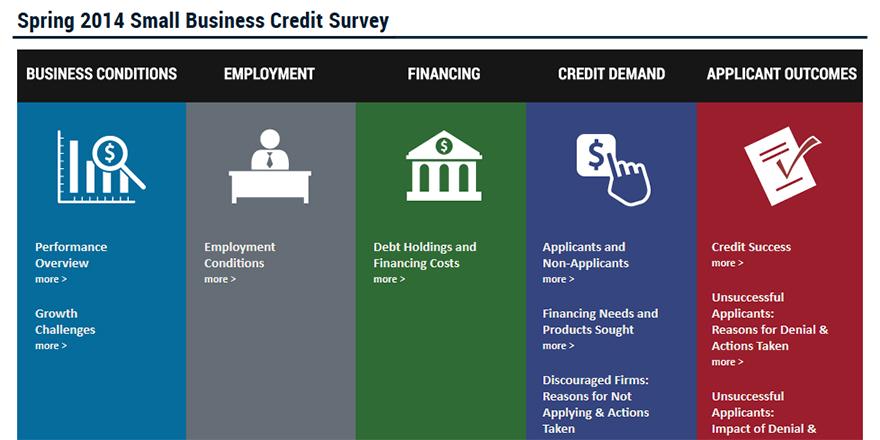
The New York Fed's Small Business Credit Survey (image via @NYFed_News)
Small businesses are critical to the jobs recovery. They employ half of private sector workers and have generated roughly two-thirds of the nation's net new jobs since 1995. Despite the economic significance of this sector, local policymakers lack high quality information about small firms' performance and their financing and investment decisions, including decisions to hire new workers. The New York Fed, working with a coalition of community partners, is trying to fill this gap.
Since 2010, the New York Fed's Outreach Team has surveyed small businesses in the greater New York region about their performance, financing needs and choices, and employment experiences. We work with organizations that serve the business community—including government agencies, chambers of commerce, and nonprofit service organizations—to gather timely intelligence and help shape programs that benefit small business owners.
Two themes have emerged from the survey: unmet small dollar credit needs (loans of $250k or less) and high credit application costs.
First, small business loans under $250k are the most frequently needed and hardest to come by. According to the latest Small Business Credit Survey (SBCS), 90% of small businesses in our region that applied for credit in 2013 sought amounts under $1 million, with the bulk of demand under $250k. These figures are consistent with national data, which show that small dollar lending through large and small banks hasn't returned to pre-recession levels.
Why do firms need small dollar loans? The most common need is working capital to finance day-to-day operations, including financing inventory for an outstanding contract or to smooth seasonal cash flow. However, approval rates for these smaller amount loans were significantly lower than those for higher dollar amounts. The most common credit challenges are weak performance, often resulting in a weak credit score, and insufficient collateral.
City and state officials at the Department of Small Business Services and Empire State Development have used these insights to shape industry-specific loan and grant programs and to design post-Superstorm Sandy recovery programs. Our team at the New York Fed has used the findings to shape Access to Capital workshops, which we hold regularly in New York, New Jersey, and Connecticut. The workshops demystify the credit application process by featuring direct conversations with lenders. They also introduce businesses that cannot qualify for traditional credit to alternative credit sources such as community development financial institutions, which can assume greater risk than banks and feature credit products designed to introduce (or reintroduce) firms into the financial mainstream.
A second and related finding from our research is that the credit search process can be quite costly in time and effort. Small business borrowers report spending more than 30 hours on average applying for loans—the better part of a workweek of a full-time employee. Consistent with this, small firms report growing interest in obtaining credit from non-traditional sources, including online lenders, which promise faster credit decisions. Even though this market currently represents less than $10 billion in outstanding loan capital, compared to the $700 billion from traditional sources, it is estimated that the portfolio balance of online lenders is doubling every year.
While the online sector has streamlined the credit application process, the terms and conditions can be quite costly. For example, online balance sheet lenders like OnDeck and Kabbage typically provide small short-term loans at an annualized rate that can range anywhere between 30 to 120 percent. Peer-to-peer lenders like Lending Club and Prosper, on the other hand, normally target near-prime borrowers and lend larger amounts for longer terms; interest rates for these loans range from 8 to 24 percent.
Given the importance of these trends for the economic health of small businesses and the US economy, the New York Fed remains committed to finding ways to maximize opportunities from credit innovations and minimize risk. Our goal is to provide high quality information and analysis on small businesses and to increase transparency about new sources of credit that may profoundly affect firms' financing options.
***
by Claire Kramer, AVP, Director of Community Development, and Diego Aragon, Associate Director, Outreach and Education
Find the New York Fed on Twitter @NYFed_News and on Facebook here.
City Must Act to Close MTA Funding Gap
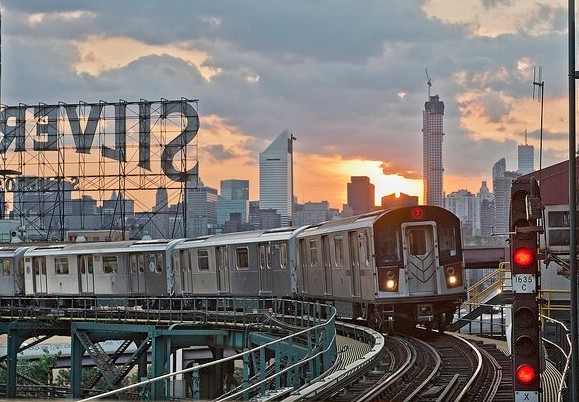
(photo: @MTA)
Last month, the MTA submitted its five year capital budget. The $32 billion plan would provide critical funding for the replacement of subway cars and buses, the modernization of signal and communication systems, and major expansion projects like East Side Access and the Second Avenue Subway. While the capital plan is essential to the continued functioning of New York's century-old transit system, there was a hitch: $15.2 billion remains unfunded. How can the MTA close this gaping hole in its budget? With strong leadership and creativity from Mayor Bill de Blasio; wrangling funding from Albany and Washington while increasing the city's financial support.
Over the last twenty-five years, the City's direct contribution to the MTA capital program has fallen markedly. In 1989, Mayor Ed Koch allocated $950 million to the Authority – representing a 15 percent share of the city's total capital budget. By 2007, that contribution fell to $124 million, a 1.4 percent share. And while the City's funding of the 7 Train extension - via the Hudson Yards Investment Corporation - provided a bump over the last five years, its $449 million contribution in 2013 was less than half its 1989 total.

With the 7 Train extension nearing completion, the city mustn't allow its funding to return to mid-2000s levels. In its capital plan, the MTA budgeted only $131 million per year from the city over next half decade. Mayor de Blasio should consider tripling or quadrupling that sum.
In the past, the City's allocation to the MTA has been highly targeted. During his final term, Mayor Koch made a generous contribution to replace the Transit Authority's aging and graffiti-stricken subway cars. Mayor de Blasio and the City Council should take a similar tact, devoting dollars to a specific priority.
Across the transit system, there are a number of urgent needs. According to the Center for an Urban Future's Caution Ahead report, for instance, 37 percent of the subway's signal system has exceeded its fifty-year useful life and approximately 1,000 subway cars running along the A, C and E lines were built prior to 1975.
The MTA's fare-collection system too, is nearly obsolete. Officials have warned that its MetroCard turnstiles cannot be maintained beyond 2019. As the Transit Authority begins to implement a contactless, smart-card payment system, the City's new Municipal ID card could serve as a platform. In Boston, Massachusetts Bay Transportation Authority (MBTA) passes are built into the One Card for students. New York could fund a similarly integrated ID, helping the MTA adopt a modern fare-collection system while ensuring broad adoption of the new Municipal ID card.
The City can also help the MTA develop new funding streams. The second phase of the Second Avenue Subway, running from 96th Street to 125th, will be a boon to East Harlem developers. The City could follow London's lead, establishing a Community Infrastructure Levy on each square foot of new construction in the neighborhood. As developers profit from increased investment in public infrastructure, it is only fair that they contribute to this investment. The return on the levy could be divided between the subway extension and the city's affordable housing fund.
Importantly, the City cannot allow Albany off the hook. The current five year plan assumes zero capital contributions from the State. While Albany does contribute to the MTA operating budget, this is drawn from dedicated revenue sources that largely originate in New York City – like the corporate franchise tax surcharge and real estate transfer taxes. Discretionary funding for the MTA, on the other hand, was cut by $30 million this year.
Given that the city – and by extension, the subway – is New York's primary economic engine, this is unacceptable. Mayor de Blasio should work with Governor Cuomo, ensuring that any increase in the city's allocation be matched or multiplied by Albany – sourced, perhaps, from the state's new infrastructure bank.
The City should also press the MTA to more equitably distribute its capital funding across the subway and regional rail systems it operates. The 2015-2019 capital plan devotes 25 percent of rail funding to the LIRR and MetroNorth, despite the subway representing 91 percent of the Authority's ridership. If funding were divided according to ridership, the subway system would receive an additional $3.6 billion. Though perfect parity is not necessarily advisable, Mayor de Blasio should negotiate for a fairer distribution.
The subway is New York City's central circulatory system. Its 660 miles of track connect residents from Van Cortlandt Park to Coney Island, Flushing to Times Square. It is the thread that stitches the five boroughs together and a bellwether of New York's fortunes: as goes the MTA, so goes the city. To ensure New York's continued economic viability and quality of life, the upcoming capital plan must be fully funded. To do so, the Mayor and the Council – as well as the Governor – must take action.
***
Adam Forman is research associate at the Center for an Urban Future, a New York City based think tank. He is the author of "Caution Ahead," a report published in March by the Center documenting New York's infrastructure vulnerabilities.
***
@GothamGazette
Do you have an op-ed idea or submission for Gotham Gazette? Send it to Executive Editor Ben Max: This email address is being protected from spambots. You need JavaScript enabled to view it.